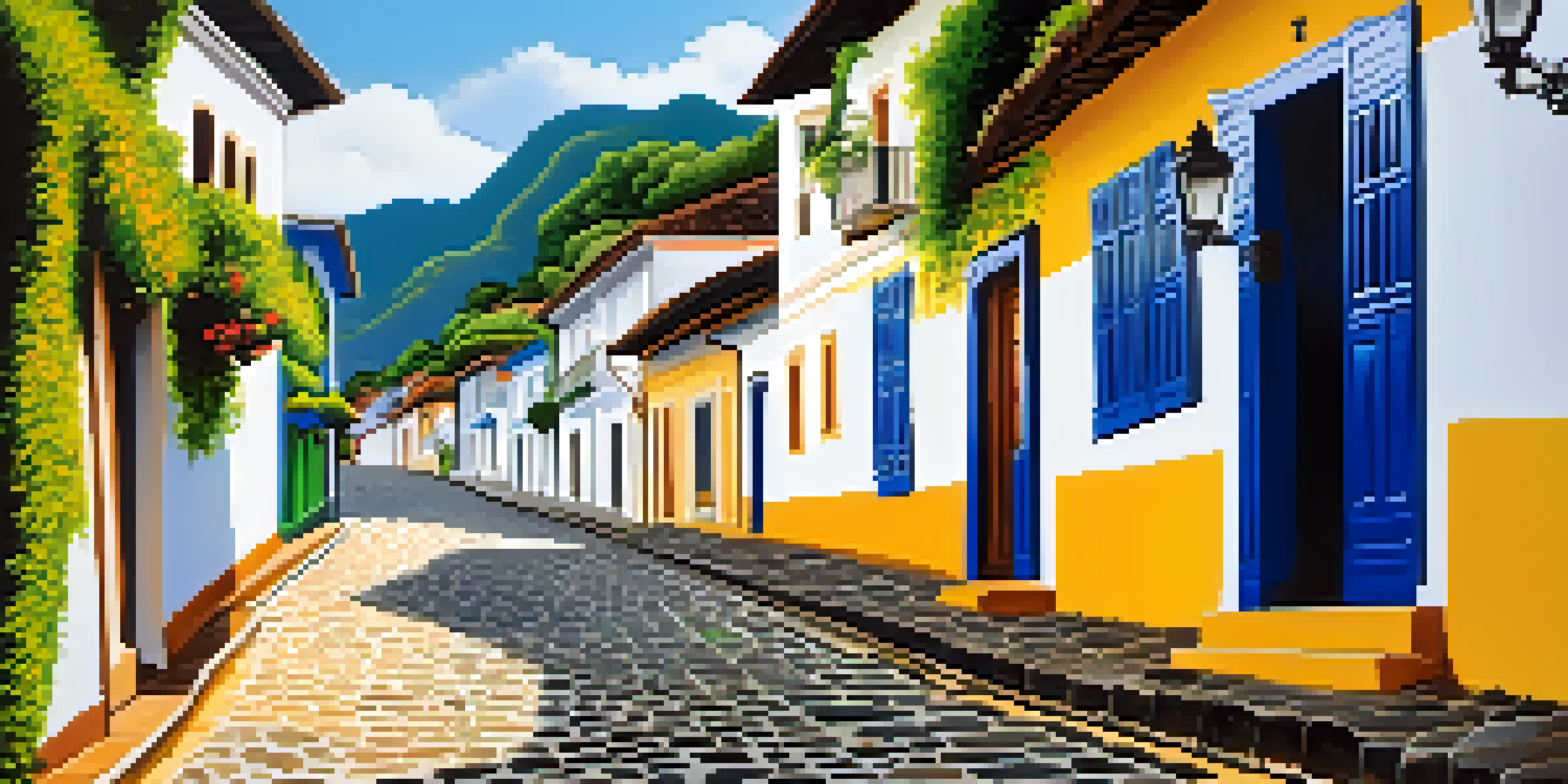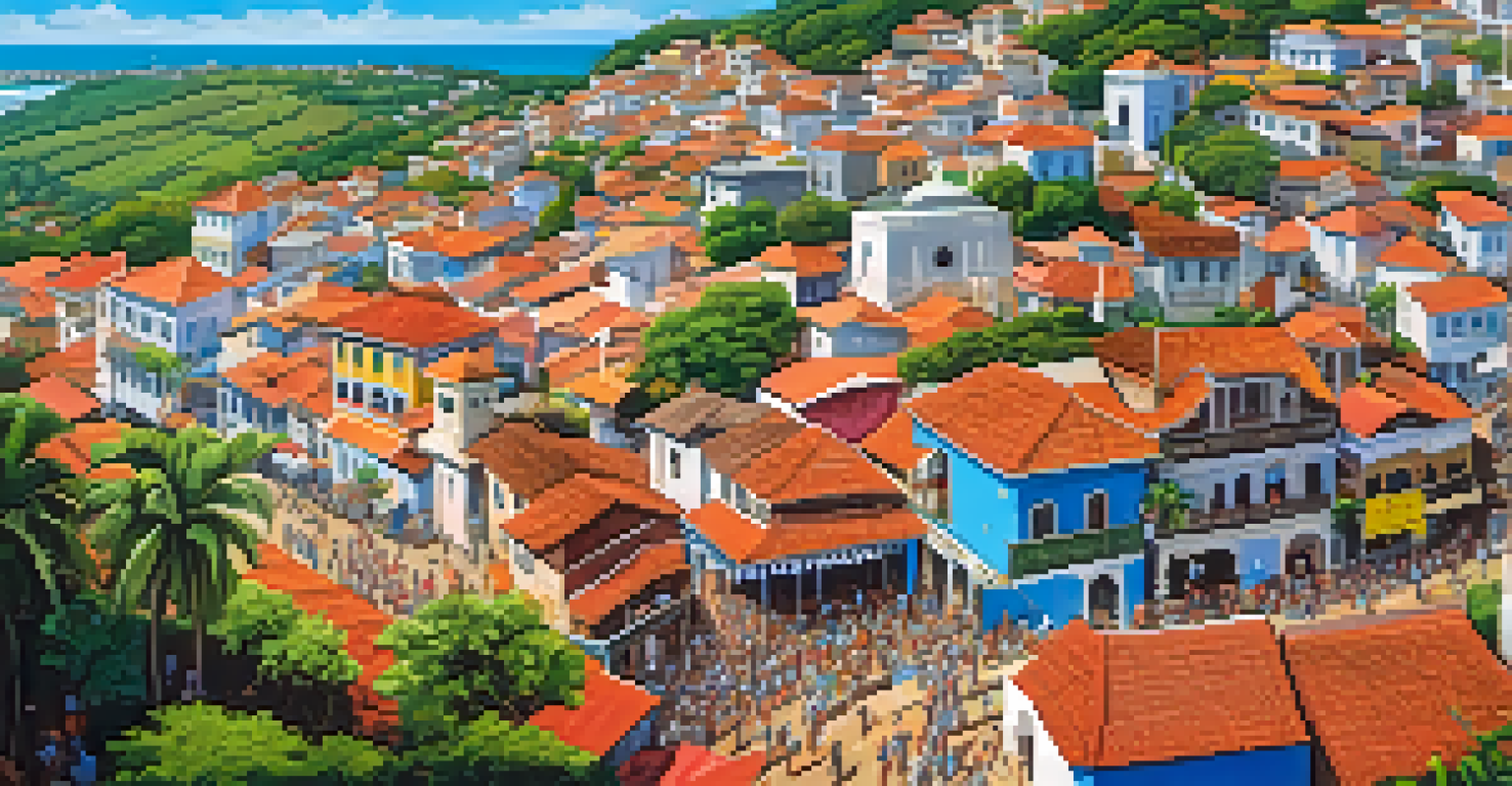Hidden Gems: Lesser-Known Colonial Towns in Brazil

The Allure of Brazil's Colonial History
Brazil's colonial history is rich and diverse, marked by Portuguese influence that still lingers in architecture, culture, and cuisine. While cities like Salvador and Ouro Preto attract the most visitors, there are countless lesser-known towns that also showcase this vibrant history. These hidden gems offer a unique glimpse into Brazil's past, often with fewer crowds and a more authentic experience.
Travel not to escape life, but so life doesn't escape you.
Imagine strolling through cobblestone streets lined with colorful colonial buildings, each telling a story of a bygone era. The charm of these towns lies not only in their historical significance but also in their serene atmospheres. You can almost hear the whispers of history as you explore these picturesque locales.
Visiting these towns allows you to appreciate the subtleties of Brazilian culture away from the hustle and bustle of tourist hotspots. You get a chance to interact with locals, taste traditional foods, and immerse yourself in the rhythm of daily life, all while soaking in the stunning landscapes that frame these enchanting places.
Paraty: A Coastal Treasure
Nestled between lush mountains and the sparkling sea, Paraty is a coastal town that perfectly blends colonial charm with natural beauty. Known for its well-preserved historical center, Paraty features beautiful whitewashed buildings with vibrant accents, making it a photographer's paradise. The town's rich history is evident in its cobblestone streets and historic churches, which date back to the 18th century.

Aside from its architecture, Paraty is also famous for its stunning beaches and nearby islands. You can take a boat tour to explore hidden coves and enjoy the crystal-clear waters, making it an ideal spot for relaxation or adventure. The vibrant cultural scene, including art galleries and festivals, adds to the town's allure, drawing visitors year-round.
Explore Brazil's Hidden Colonial Gems
Brazil's lesser-known colonial towns offer rich history and authentic cultural experiences away from the tourist crowds.
Paraty truly shines during its renowned literary festival, Flip, which attracts authors and book lovers from around the globe. This unique event highlights the town's commitment to literature and arts, transforming it into a lively hub of creativity and inspiration, further solidifying its status as a hidden gem.
Tiradentes: A Step Back in Time
Tiradentes, a small town in Minas Gerais, is often overshadowed by its more famous neighbors but offers a unique glimpse into Brazil's colonial past. The town is named after the national hero Joaquim José da Silva Xavier, also known as Tiradentes, who played a crucial role in Brazil's independence. Wandering through Tiradentes feels like stepping back in time, as the well-preserved colonial architecture tells stories of resilience and hope.
The journey of a thousand miles begins with one step.
The charming streets are lined with quaint shops, artisanal markets, and cozy cafes where you can savor delicious local dishes. One must-try is the famous 'tutu de feijão,' a traditional bean dish that warms the heart. The town also hosts several festivals throughout the year, celebrating everything from music to gastronomy, making it a lively destination.
Beyond its historical significance, Tiradentes is surrounded by breathtaking landscapes. You can hike nearby mountains or explore the lush countryside, offering a perfect blend of culture and nature. This enchanting town invites you to slow down and appreciate the simple joys of life, making it a true hidden gem in Brazil.
São João del Rei: A Cultural Hub
São João del Rei is another lesser-known colonial town that boasts a rich cultural heritage and striking architecture. The town is famous for its baroque churches, particularly the Church of Saint Francis of Assisi, whose intricate details leave visitors in awe. This town serves as a cultural hub, with a plethora of music and art festivals that celebrate its vibrant local traditions.
Visitors can enjoy a leisurely stroll along the charming streets, soaking in the ambiance and perhaps catching a glimpse of a street performance. The town is also known for its historical significance in Brazil's independence movement, adding depth to its already fascinating narrative. As you explore, you may find yourself drawn to the town's unique charm and warm hospitality.
Unique Attractions in Each Town
Each town, from Paraty's beaches to Olinda's vibrant carnival, showcases distinct architectural beauty and cultural significance.
One of the highlights of visiting São João del Rei is the opportunity to take a scenic train ride to the nearby town of Tiradentes. This picturesque journey allows you to appreciate the stunning landscapes of the region while connecting two beautiful towns rich in history and culture. It's a delightful experience that adds a touch of adventure to your exploration.
Olinda: A Colorful Celebration
Olinda is a vibrant town known for its colorful colonial buildings, rich culture, and lively carnival celebrations. Perched on a hill overlooking the Atlantic Ocean, Olinda's historic center is a UNESCO World Heritage site filled with well-preserved churches and art galleries. The town's bohemian atmosphere attracts artists and musicians, making it a hub of creativity and expression.
Wandering through Olinda feels like stepping into a living art gallery, where every corner is adorned with murals and sculptures. The annual carnival, celebrated with fervor, transforms the streets into a whirlwind of music, dance, and vibrant costumes. This lively event showcases the town's rich cultural heritage and invites visitors to join in the festivities.
Beyond the carnival, Olinda offers a slower pace of life, with plenty of cozy cafes and artisan shops to explore. You can enjoy a local dish, such as 'bolo de rolo,' a traditional cake, while taking in the stunning views of the coastline. This delightful mix of culture, history, and natural beauty makes Olinda a must-visit hidden gem.
Diamantina: A Jewel of the Past
Diamantina, nestled in the mountainous region of Minas Gerais, is a charming colonial town that once thrived during the diamond rush of the 18th century. Its cobbled streets and colonial mansions reflect the town's prosperous history, making it a captivating destination for history enthusiasts. The local architecture showcases a blend of Portuguese and African influences, adding to its unique charm.
The town is also known for its vibrant music scene, particularly the traditional genre of 'choro.' Visitors can enjoy live performances in local bars, where the rhythm of the music fills the air, inviting you to sway along. The annual Festival of Choro celebrates this rich musical heritage, drawing both locals and tourists eager to indulge in the lively atmosphere.
Engage with Local Traditions
Traveling to these towns allows visitors to connect with local culture through traditional foods, music, and community festivals.
Nature lovers will appreciate Diamantina's proximity to stunning national parks and hiking trails. The breathtaking views and diverse wildlife provide a perfect backdrop for outdoor adventures. Whether you're exploring its rich history or immersing yourself in its vibrant culture, Diamantina truly stands out as a hidden jewel in Brazil.
The Unique Charm of Parnaíba
Parnaíba is a lesser-known colonial town located near the Parnaíba River and the stunning Delta do Parnaíba. This picturesque destination boasts a unique blend of natural beauty and colonial architecture, with charming streets lined with colorful buildings. The town's historical significance is highlighted by the well-preserved churches and squares that invite exploration.
One of the unique aspects of Parnaíba is its proximity to the delta, one of the largest in the world. Visitors can embark on boat tours to explore the rich biodiversity of the region, spotting exotic birds and diverse wildlife along the way. The breathtaking landscapes provide ample opportunities for photography and adventure, making it a perfect getaway for nature enthusiasts.

Additionally, Parnaíba is known for its cultural festivals, celebrating local traditions and cuisine. The lively atmosphere during these events allows you to experience the warmth and hospitality of the locals. With its perfect mix of history, nature, and culture, Parnaíba is an underrated gem waiting to be discovered.
Conclusion: Embrace the Hidden Gems of Brazil
Exploring Brazil's lesser-known colonial towns is like uncovering hidden treasures that offer a glimpse into the country's rich history and diverse culture. From the coastal beauty of Paraty to the vibrant streets of Olinda, each town provides a unique experience that captivates the heart and soul. These hidden gems not only invite you to explore their historical significance but also encourage you to connect with the local culture.
Traveling to these lesser-known destinations allows you to escape the crowds and immerse yourself in the authentic Brazilian way of life. You might find yourself enjoying a leisurely meal with locals or dancing to traditional music at a festival, creating memories that will last a lifetime. The beauty of these towns lies in their ability to transport you to a different time and place, where history and culture intertwine.
So, whether you're a history buff, an adventure seeker, or simply someone looking to experience Brazil beyond the tourist trail, these hidden gems offer something special. Pack your bags and get ready to discover the charm and allure of Brazil's colonial towns, where every corner holds a story waiting to be told.